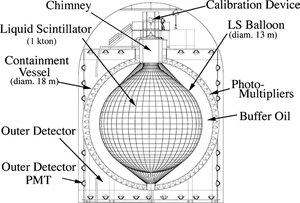
36°25′21″N 137°18′55″E / 36.4225°N 137.3153°E[1]: 105 The Kamioka Liquid Scintillator Antineutrino Detector (KamLAND) is an electron antineutrino detector at the Kamioka Observatory, an underground neutrino detection facility in Hida, Gifu, Japan. The device is situated in a drift mine shaft in the old KamiokaNDE cavity in the Japanese Alps. Although located in the Kamioka Observatory, which is part of the University of Tokyo, this project is conducted by a team at Tohoku University. The site is surrounded by 53 Japanese commercial nuclear reactors. Nuclear reactors produce electron antineutrinos () during the decay of radioactive fission products in the nuclear fuel. Like the intensity of light from a light bulb or a distant star, the isotropically-emitted flux decreases at 1/R2 per increasing distance R from the reactor. The device is sensitive up to an estimated 25% of antineutrinos from nuclear reactors that exceed the threshold energy of 1.8 megaelectronvolts (MeV) and thus produces a signal in the detector.
If neutrinos have mass, they may oscillate into flavors that an experiment may not detect, leading to a further dimming, or "disappearance," of the electron antineutrinos. KamLAND is located at an average flux-weighted distance of approximately 180 kilometers from the reactors, which makes it sensitive to the mixing of neutrinos associated with large mixing angle (LMA) solutions to the solar neutrino problem.
- ^ Iwamoto, Toshiyuki (February 2003), Measurement of Reactor Anti-Neutrino Disappearance in KamLAND (PDF) (Ph.D. thesis), Tohoku University, archived from the original (PDF) on 2014-10-06
